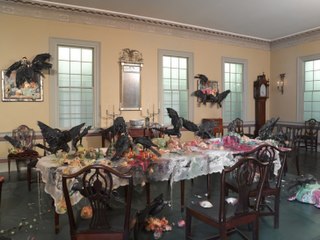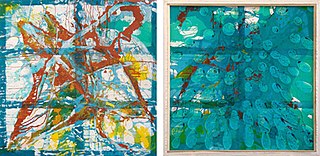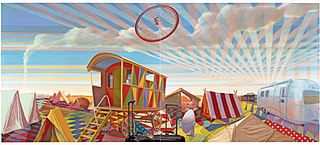
Amy Sillman is a New York-based visual artist, known for process-based paintings that move between abstraction and figuration, and engage nontraditional media including animation, zines and installation. Her work draws upon art historical tropes, particularly postwar American gestural painting, as both influences and foils; she engages feminist critiques of the discourses of mastery, genius and power in order to introduce qualities such as humor, awkwardness, self-deprecation, affect and doubt into her practice. Profiles in The New York Times, ARTnews, Frieze, and Interview, characterize Sillman as championing "the relevance of painting" and "a reinvigorated mode of abstraction reclaiming the potency of active brushwork and visible gestures." Critic Phyllis Tuchman described Sillman as "an inventive abstractionist" whose "messy, multivalent, lively" art "reframes long-held notions regarding the look and emotional character of abstraction."

Derek Fordjour is an American interdisciplinary artist and educator of Ghanaian heritage who works in collage, video/film, sculpture, and painting. Fordjour lives and works in New York City.
Federico Solmi is a visual artist based in Brooklyn, New York.

Katherine Bradford, née Houston, is an American artist based in New York City, known for figurative paintings, particularly of swimmers, that critics describe as simultaneously representational, abstract and metaphorical. She began her art career relatively late and has received her widest recognition in her seventies. Critic John Yau characterizes her work as independent of canon or genre dictates, open-ended in terms of process, and quirky in its humor and interior logic.
Carrie Moyer is an American painter and writer living in Brooklyn, New York. Moyer's paintings and public art projects have been exhibited both in the US and Europe since the early 1990s, and she is best known for her 17-year agitprop project, Dyke Action Machine! with photographer Sue Schaffner. Moyer's work has been shown at the Whitney Biennial, the Museum of Arts and Design, and the Tang Museum, and is held in the permanent collections of the Metropolitan Museum of Art. She serves as the director of the graduate MFA program at Hunter College, and has contributed writing to anthologies and publications like The Brooklyn Rail and Artforum.
Juan Sánchez, also Juan Sanchez is an American artist and educator. He is an important Nuyorican cultural figure to emerge in the second half of the 20th century. His works include photography, paintings and mixed media works.
Amy Feldman is an American abstract painter from Brooklyn, New York.

Valerie Hegarty is an American painter, sculptor, and installation artist. She is known for irreverent, often critical works that replicate canonical paintings, furnishings, and architectural spaces from American or personal history undergoing various processes of transformation. Hegarty most often portrays her recreations in meticulously realized, trompe l’oeil states of decay, ruin, or physical attack related to their circumstances. Her work examines American historical themes involving colonization, slavery, Manifest Destiny, nationalism, art-historical movements and their ideological tenets, romantic conceptions of nature, and environmental degradation. Sculpture critic Robin Reisenfeld wrote that among other things, Hegarty's art is "informed by 19th-century American landscape painting as an expression of the sublime, as well as by the manufacturing of two-dimensional 'masterworks' to be destroyed in three-dimensional fashion in order to evoke entropic forces of growth and decay."

Candida Alvarez is an American artist and professor, known for her paintings and drawings.

Dona Nelson is an American painter, best known for immersive, gestural, primarily abstract works employing unorthodox materials, processes and formats to disrupt conventional notions of painting and viewership. A 2014 New Yorker review observed, "Nelson gives notice that she will do anything, short of burning down her house to bully painting into freshly spluttering eloquence." Since 2002, long before it became a more common practice, Nelson has produced free-standing, double-sided paintings that create a more complex, conscious viewing experience. According to New York Times critic Roberta Smith, Nelson has dodged the burden of a "superficially consistent style," sustained by "an adventuresome emphasis on materials" and an athletic approach to process that builds on the work of Jackson Pollock. Writers in Art in America and Artforum credit her experimentation with influencing a younger generation of painters exploring unconventional techniques with renewed interest. Discussing one of Nelson's visceral, process-driven works, curator Klaus Kertess wrote, the paint-soaked "muslin is at once the tool, the medium, and the made."
Nancy Shaver is an American visual artist based in Jefferson, New York.
Chie Fueki is a Japanese American painter. She has had an active career exhibiting her work in commercial galleries, and has been awarded a Guggenheim Foundation Fellowship. Fueki's intricate paintings combine influences from both Eastern and Western traditions. She currently lives and works in Beacon, New York.
Ann Pibal is an American painter who makes geometric compositions using acrylic paint on aluminum panel. The geometric intensity is one of the key characteristics that defines her paintings.
Maria Gaspar is an American interdisciplinary artist and educator.

Joanna Pousette-Dart is an American abstract artist, based in New York City. She is best known for her distinctive shaped-canvas paintings, which typically consist of two or three stacked, curved-edge planes whose arrangements—from slightly precarious to nested—convey a sense of momentary balance with the potential to rock, tilt or slip. She overlays the planes with meandering, variable arabesque lines that delineate interior shapes and contours, often echoing the curves of the supports. Her work draws on diverse inspirations, including the landscapes of the American Southwest, Islamic, Mozarabic and Catalan art, Chinese landscape painting and calligraphy, and Mayan art, as well as early and mid-20th-century modernism. Critic John Yau writes that her shaped canvasses explore "the meeting place between abstraction and landscape, quietly expanding on the work of predecessors", through a combination of personal geometry and linear structure that creates "a sense of constant and latent movement."

Greg Drasler is an American artist known for metaphorical paintings that mix vernacular imagery and decoration and visual and interpretive conundrums. His work explores the construction of identity and memory through painted subjects that range from elaborately constructed interiors to symbolic common objects to patterned panoramas of the American highway. Although representational, Drasler's work eludes defined aesthetic categories such as realism, incorporating elements of surrealism, abstraction, and postmodern bricolage and recontextualization. In an early Art in America review, Robert G. Edelman wrote that Drasler "shares with Magritte the ability to create images that are both convincing and profoundly disorienting"; Jonathan Goodman described his later paintings as enigmatic puzzles meant to be meditated on, as both "visual metaphors for self" and formal statements existing for the sake of psychological mystery. Drasler has been awarded a Guggenheim Fellowship and grants from the Pollock-Krasner Foundation, National Endowment for the Arts and New York Foundation for the Arts. His work has been shown at the New Museum, PS1, Whitney Museum Stamford, Artists Space and Carnegie Museum of Art, and reviewed or featured in Art in America, Flash Art, New Art Examiner, The Paris Review, and The New York Times. Drasler lives in Tribeca, New York City with his wife, artist Nancy Davidson, and teaches at Pratt Institute.

Louise Belcourt is a Canadian-American artist based in New York, known for elusive, largely abstract paintings that blend modernist formal play, a commitment to the physical world, and a visual language that shifts between landscape and the body, architecture and geometric form. New York Times critic Ken Johnson writes of her earlier work, "balancing adroitly between Color Field abstraction and Pop-style representation, Ms. Belcourt's paintings invite meditation on the perceptual, the conceptual and how our minds construct the world." Describing her later evolution, David Brody writes in Artcritical, "Hard-nosed Canadian empiricism and Brooklyn grit seem to combine in Belcourt’s work to undermine stylistic stasis."

Harriet Korman is an American abstract painter based in New York City, who first gained attention in the early 1970s. She is known for work that embraces improvisation and experimentation within a framework of self-imposed limitations that include simplicity of means, purity of color, and a strict rejection of allusion, illusion, naturalistic light and space, or other translations of reality. Writer John Yau describes Korman as "a pure abstract artist, one who doesn’t rely on a visual hook, cultural association, or anything that smacks of essentialization or the spiritual," a position he suggests few post-Warhol painters have taken. While Korman's work may suggest early twentieth-century abstraction, critics such as Roberta Smith locate its roots among a cohort of early-1970s women artists who sought to reinvent painting using strategies from Process Art, then most associated with sculpture, installation art and performance. Since the 1990s, critics and curators have championed this early work as unjustifiably neglected by a male-dominated 1970s art market and deserving of rediscovery.
Sheree Hovsepian is an Iranian-born American artist. She primarily works in photography and collage, in addition to sculpture and drawing. Her work is often concerned with the human form and matters of identity. She is based in New York City, with houses in the Gramercy Park neighborhood and in Bridgehampton in the Hamptons.

Medrie MacPhee is a Canadian-American painter based in New York City. She works in distinct painting and drawing series that have explored the juncture of abstraction and representation, relationships between architecture, machines, technology and human evolution, and states of flux and transformation. In the 1990s and 2000s, she gained attention for metaphorical paintings of industrial subjects and organic-machine and bio-technological forms. In later work, she explored architectural instability before turning to semiotically dense canvases combining compartments of color and collaged pieces of garments fit together like puzzles, which New York Times critic Roberta Smith described as "powerfully flat, more literal than abstract" with "an adamant, witty physicality."











